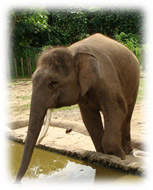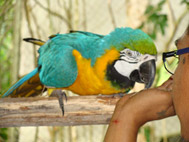
|

|
|
<< MID-BCC home page Blog Home ArchiveBy MonthJuly 2012 (2)June 2012 (1)May 2012 (3)April 2012 (5)March 2012 (1)By CountryCambodia (4)Lao PDR (4)Malaysia (1)Mozambique (1)Vietnam (2)By ProjectMID-BCC (9)PREVENT Project (3)
|
Sabah PREVENT VisitBy Anton Schneider May 8, 2012 Monday afternoon, April 16 – Laboratory and Wildlife Rescue CenterFollowing lunch, I accompanied Sabah Wildlife Department and EcoHealth Alliance staff to the newly constructed Wildlife Health Unit Laboratory and Wildlife Rescue Unit. The laboratory will be supported by the Sabah Wildlife Department, EcoHealth Alliance (using PREDICT and other funds), Danau Girang Field Centre and the Malaysian Palm Oil Council. The Lab will be used for zoonotic disease screening of rescued, relocated wildlife and PREDICT wildlife samples as well as some genetic and forensic work.  Wildlife Health Unit Laboratory and Rescue Center
Both buildings are still under construction, though mostly completed. We were pleased to see that the building housing the laboratory was completed and the minus 80-degree freezer had already been installed, as well as interior walls, windows, tiles and sinks. During this visit, Mr. Hughes carefully reviewed the specifications for the laboratory, made additional measurements, and recommended several structural adjustments to ensure that the laboratory would be functional and could be certified to meet necessary biosecurity levels.
Following the laboratory assessment visit, the team moved to the adjoining building, which houses the wildlife rescue center. The frowns and serious looks seen in the laboratory were quickly transformed into broad smiles as we met several orphans rescued from the jungle - two rescued baby elephants, several gibbons, and a sun bear.
These animals are all orphans who lost their parents in Sabah's beautiful forests, and have been rescued and are being cared for by Sabah Wildlife Officials in the newly constructed rescue center. During our visit we discussed how best to protect both humans and wildlife through improved hygiene, infection prevention measures and use of protective equipment, such as gloves.
The fact that these animals lost their parents is a vivid reminder of the vital connection between wildlife and habitat and the serious threats that wildlife faces in these beautiful jungles. Interacting with these creatures gave us all a visceral reminder of our own deep, shared connections with wildlife as part of “One World-One Health”. April 16 – Afternoon – Lok Kawi Wildlife Park
Other primate species at Lok Kawi include Proboscis Monkeys and Gibbons.
Like Orangutans, the Proboscis Monkeys are native to Borneo and both are facing the threat of extinction due to loss of habitat and human intervention.
The park also has Malayan Sun bears, the smallest bear in the world, Pygmy Elephants, several Malaysian Tigers, Otters, Mouse Deer, Ostrich, Civets and an aviary that is actually an untouched area of jungle.  This elephant was born and raised in the park and his attachment to one of the wildlife officials was apparent. He ran over the minute he saw us, and wanted to play.
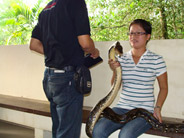
Having completed my one and a half day visit to Sabah, I am excited to think ahead to our next steps and future work with EcoHealth Alliance and the Sabah Wildlife Department. Based on our discussions, our next step to implementing the human-wildlife exposure study will be for our EPT PREDICT partner, EcoHealth Alliance, to select the field sites for wildlife sampling. PREVENT will then conduct a scoping visit to the field sites to identify sampling issues and fieldwork logistics. During the next visit, we also plan to meet with the Ministry of Health as well as a return visit to the Sabah Wildlife Department. After all, our work in Sabah is for the prevention of disease affecting both wildlife and humans!
PREVENT Project is funded by USAID. Photos by Anton Schneider 2012 | FHI 360
|
|||||||||||||||||||||||
|
Copyright© 2011 FHI360 1825 Connecticut Avenue NW Washington, DC 20009 - 5721 
The Mekong Infectious Disease Behavior Change and Communication Project is funded by the United States Agency for International Development (USAID)/Global Health under Client Associate Award Number GHN-A-00-09-00002-00 under Leader Award (C-Change) No. GPO-A -00-07-00004-00 and managed by FHI 360. The information provided on this site is the responsibility of FHI 360 and is not official information from the U.S. Government and does not represent the views or positions of USAID or the U.S. Government. |
||||||||||||||||||||||||











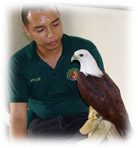
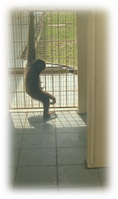 Later in the afternoon, I was taken by staff of Sabah Wildlife on a visit to Lok Kawi Wildlife Park, which is managed by the Sabah Wildlife Department. The Park is a short drive on the outskirts of Kota Kinabalu. It is open to the public and dedicated to improving the public's awareness of the precious wildlife that is native to Malaysia, and Sabah, specifically. The park also provides an opportunity for environmental education, research and captive breeding.
Later in the afternoon, I was taken by staff of Sabah Wildlife on a visit to Lok Kawi Wildlife Park, which is managed by the Sabah Wildlife Department. The Park is a short drive on the outskirts of Kota Kinabalu. It is open to the public and dedicated to improving the public's awareness of the precious wildlife that is native to Malaysia, and Sabah, specifically. The park also provides an opportunity for environmental education, research and captive breeding. The park features several species of wildlife unique to Sabah and native to Borneo, including the Borneo Pigmy Elephants, Proboscis Monkey, and, the famous Orangutan, whose name means “man of the jungle.” Orangutans are solitary and difficult to spot in the wild. Even here, in the park, they were a bit “shy.”
The park features several species of wildlife unique to Sabah and native to Borneo, including the Borneo Pigmy Elephants, Proboscis Monkey, and, the famous Orangutan, whose name means “man of the jungle.” Orangutans are solitary and difficult to spot in the wild. Even here, in the park, they were a bit “shy.” 



